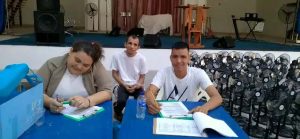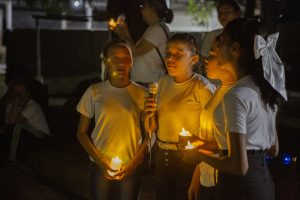Huntington’s disease (HD) is a genetic, fatal, and progressive neurodegenerative disease. HD does not discriminate based on ethnicity or gender. It advances slowly, but relentlessly. The disease is caused by mutations in a single gene, called Huntingtin, and the penetrance of the mutation is 100%.
If one is born with a Huntingtin mutation, today one will die from Huntington’s disease (provided he/she lives long enough).
Latin America holds a special place in the scientific history of HD. The identification of the mutation causing HD was achieved after an international effort because of the large numbers of related, affected people living in the Maracaibo region of Venezuela. However, after 20 years since the discovery of the gene, the quality of life of affected people in Venezuela and elsewhere has changed very little. It is out of this fact and out of a desire to help these affected communities, that the concept behind ‘Factor-H’ was born. HD is highly prevalent across many communities in Latin America. Geographical isolation and the individual histories of these communities have contributed to a prevalence of the disease that in some cases is 500-1000 times higher than in other regions. The consequences of this high prevalence, and the poverty conditions in which these communities exist, have led to a situation that requires immediate attention. Poverty, ignorance and disease are a terrible combination that leads to inadequate healthcare, nutrition and living conditions. Juvenile HD cases are abundant, and in many instances entire families are incapacitated to care for themselves because so many of the family members are affected.
Significant advances in HD research benefitted greatly from several decades of field studies of Venezuelan populations afflicted by the disease, located on the western shores of Lake Maracaibo. In 1993, the work by the Huntington’s Disease Collaborative Research Group culminated in the discovery of the causative mutation in 1993. Many scientific and medical findings that have greatly impacted our understanding of the disease, including the identification of the causative gene, the evidence for a toxic gain of function of the mutation through the study of homozygote individuals, and the identification of modifier genes that alter the age of onset of HD (an area of renewed therapeutic interest), was made possible through the extensive participation of these Venezuelan HD patients, their families and their communities.
Throughout Latin America there are a number of communities (or ‘clusters’) where the prevalence of HD is strikingly higher than in the average population. These clusters seem to have arisen from founder populations, thought to be of European origin, who arrived in the late 18th century, in Cañete (Perú), Juan de Acosta (Colombia) and the Zulia State in Venezuela. Having visited many of these communities, we have been struck by their commonalities: many HD families live in extreme poverty, its members largely uneducated, and often lack access to basic necessities, such as fresh water, food, adequate housing, and basic care. In many locations, affected and at-risk people have little or no access to primary medical care, genetic counseling and testing, let alone access to neurological or psychiatric medications. In addition, families experience fear at being ostracized by their communities, and often times, violence against them.

One of the largest HD clusters in the world is nestled in the impoverished neighborhood of San Luis in the oil-producing town of Maracaibo, Venezuela, in which roughly a third of all families have a history of HD. Our recent informal survey suggests that 10-15% of a population of 3500 people is at risk for HD. Pioneering scientist and HD advocate Dr. Nancy Wexler founded a care center there named Casa Hogar Amor y Fe, which provided access to food and medications as well as housed 40 or so patients. However, this center has been closed for some years now, and patients lack adequate facilities. An economic study in the San Luis community has shown that the families affected with the disease are found in the lowest socio-economic layers (IV and V in Graffar’s scale). This reflects the state of human and social vulnerability of these families and the immediate need to provide healthcare.
The town of Barranquitas, 120 km away, is the largest known HD population in the world, where a third of a population of about 7000 people is thought to be at risk for HD, although the current number of cases is unknown. Barranquitas lacks a specialized care center and is by far the worst affected community in the world, in terms of the number of cases and due to a wrenching poverty. The current political and economic instability in Venezuela, as well as the toxic pollution in Lake Maracaibo due to a decaying oil infrastructure, have severely impacted conditions for this community, where most of the population is unemployed.
While extreme, the situation in Venezuela is not unique. Other populations exist in Colombia (most known are the communities in the Caribbean States of Northern Colombia), Perú, and Brazil. We have concentrated our efforts in the three largest ‘clusters’ in the world, located in Venezuela, Colombia and Perú, as they share many similarities in the context of poverty, social and economic neglect, and variable levels of medical support.







One Response
Sending Prayers and Support 💙 My Husband was diagnosed with Huntington’s disease when he was 62 years old 2 years ago. The haloperidol did very little to help him. The medical team did even less. His decline was rapid and devastating. It was tremors at first, then Walking difficulties. Last year, a family friend told us about Natural Herbs Centre and their successful Huntington’s Ayurveda TREATMENT, we visited their website natural herbs centre. com and ordered their Huntington’s Ayurveda protocol, i am happy to report the treatment effectively treated and reversed his Huntington’s disease, most of his symptoms stopped, he’s able to walk again, sleep well and exercise regularly.he’s active now, I can personally vouch for these remedy but you would probably need to decide what works best for you.